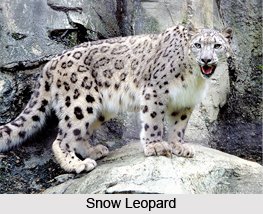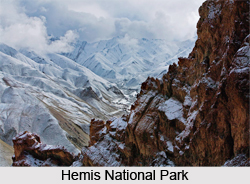 Hemis National Park or the Hemis High Altitude National Park comes under the eastern Ladakh Region of Jammu and Kashmir. It is the largest National Park in India as well as the South Asian continent with a combined area including Rumbak, Markha and Sumdah and some parts of the Zanskar Range.
Hemis National Park or the Hemis High Altitude National Park comes under the eastern Ladakh Region of Jammu and Kashmir. It is the largest National Park in India as well as the South Asian continent with a combined area including Rumbak, Markha and Sumdah and some parts of the Zanskar Range.
Location of Hemis National Park
Hemis National Park (or Hemis High Altitude National Park) is a high altitude national park in the eastern Ladakh region of the state of Jammu and Kashmir in India.
History of Hemis National Park
The park was founded in 1981 by protecting the Rumbak and Markha catchments, an area of about 600 km square (230 sq mi). It grew in 1988 to around 3,350 km square (1,290 sq mi), by incorporating neighboring lands. It increased again in 1990 to 4,400 km square (1,700 sq mi), and is the largest national park in South Asia. The park lies within the Karakoram-West Tibetan Plateau alpine steppe eco-region, and contains pine forests, alpine shrub lands and meadows, and alpine tundra.
Fauna in Hemis National Park
The park is the abode of about 200 snow leopards, Argali (Great Tibetan Sheep), Bharal (Blue Sheep), Shapu (Ladakhi Urial), and livestock including a small number of the Asiatic Ibex, Tibetan Wolf, the Eurasian Brown Bear (endangered in India), and the Red Fox. Moreover, small mammals including the Himalayan Marmot, Mountain Weasel and the Himalayan Mouse Hare are also present in Hemis National Park. Moreover, birds like Golden Eagle, Lammergeier vulture, and the Himalayan Griffon vulture are also observed in Hemis.
Flora in Hemis National Park
The major biomes in Hemis National Park include dry Himalayan subtropical pine forests, Western Himalayan alpine shrub and meadows and Himalayan Alpine tundra. The Hemis National Park is known for rare dry forests of juniper, birch, fir, alpine grasslands and scrublands. The famous flora of the Park includes sparse grasslands, herbaceous vegetation, Myricaria, Poplar, Salix, Astragalus, Taraxacum, Leortopodium, Ephedra and many sparse types of grassland. Trees and shrubs are spread across the valley bottoms. Since the upper mountain slopes are moist, this area is characterized by alpine vegetation including Anemone, Gentiana, Thallctrwn, Lloydia, Veronica, Delphinium, Carex and Kobresia. The other parts of the park support steppe vegetation which is dominated by Caragana, Artemisia, Stachys, and Ephedra, present along the lower river courses.
Best Season to Visit Hemis National Park
The climate is extreme and shows high fluctuations both on a daily and seasonal basis. Precipitation is quite low, averaging at 160.5 mm. In winter, temperatures are close to freezing point during the day. The Zanskar River and its tributaries are frozen and temperatures drop to as low as -15 degree C to -30 degree C at night. Since the winters are very harsh, so it`s best to plan a trip during the summer. April to June and September to December are the best seasons for bird-watching. For animal viewing, September to June is suitable.
Accommodation near Hemis National Park
Hemis is mainly visited by trekkers. There are no facilities for "pucca" accommodation but dormitories and tents may be used for an overnight halt. The East West guesthouse is a long walk from the Hemis gompa. Places around the gompa allow camping. One could either set up their own tent or use the pre-set tents for two.
How to Reach Hemis National Park
From June to September, one can fly to Leh from Delhi, Chandigarh, Srinagar or Jammu. Indian Airlines is the only airline with flights to Leh. In winter, however, proceeding by road is a safer option. Approachable by road from Leh, this national park contains several camping sites. The area is barren and rocky, covered only sparsely with vegetation. There is a daily bus service from Leh to Hemis.
It is the only national park in India north of the Himalayas, the largest notified protected area in India (and thus the largest national park of India), and is the second largest contiguous protected area after the Nanda Devi Biosphere Reserve and surrounding protected areas. The Hemis National Park is known to be the abode of some rare species of animals and plants that are mainly of frosty region.



















